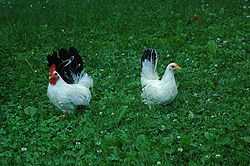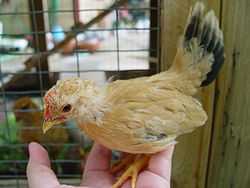Japanese bantam
 A pair of black-tailed Japanese bantams | |
| Other names | |
|---|---|
| Country of origin | Japan |
| Distribution | South Asia |
| Use | fancy |
| Traits | |
| Weight | Male: 510–600 g |
| Female: 400–510 g | |
| Skin color | yellow |
| Egg color | cream or tinted |
| Comb type | single |
| Classification | |
| PCGB | True bantam |
|
Chicken Gallus gallus domesticus | |
The Japanese bantam or Chabo is a breed of chicken originating in Japan. It is a true bantam breed, meaning that there are no large fowl counterparts. It has a large upright tail that often reaches over the bird's head. The wings angle down, and to the back, along the sides.
Variations

There are many colour varieties of Japanese bantam, with standardised colours including birchen grey, black, black mottled, black-tailed buff, black-tailed white, blue, blue mottled, blue-red, brown-red, buff Columbian, cuckoo, dark grey, golden duckwing, gray, lavender, Miller's gray, partridge, red, red mottled, silver-grey, tri-coloured, wheaten and white.[3] There are also frizzle-feathered and Silkie-feathered variations.[4][5] These chickens have been known to live for up to 13 years with proper care.
Genetics
An unusual characteristic of Japanese bantams is its extremely short legs. This trait is caused by a single lethal gene. All proper Japanese bantams are then heterozygous meaning that when the birds are bred, 25% of the embryos will receive two mutant alleles and die in shell. The other 50% of the embryos will receive one mutant allele and one wild type allele and will then be short-legged. The remaining 25% receive two wild type alleles and have legs that are longer than what most breeders want. Long-legged birds bred to each other will never produce short-leg offspring
References
- ↑ Breed data sheet: Shojo chabo/Japan. Domestic Animal Diversity Information System of the Food and Agriculture Organization of the United Nations. Accessed August 2014.
- ↑ Breed data sheet: Katsura chabo/Japan. Domestic Animal Diversity Information System of the Food and Agriculture Organization of the United Nations. Accessed August 2014.
- ↑ Liste des races et variétés homologuée dans les pays EE (28.04.2013). Entente Européenne d’Aviculture et de Cuniculture. Accessed August 2014.
- ↑ Australian Poultry Standards, 2nd Edition, Published 2012, Victorian Poultry Breeders Association
- ↑ http://www.aviculture-europe.nl/nummers/12E02A04a.pdf
| Wikimedia Commons has media related to Japanese Bantam. |
| ||||||